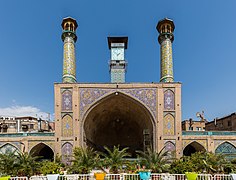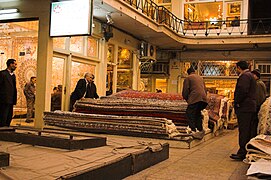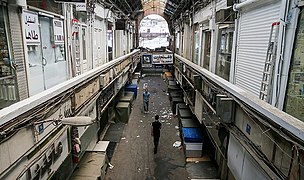Grand Bazaar, Tehran
بازار بزرگ Bāzār e Bozorg | |
 Inside the Grand Bazaar of Tehran | |
 | |
| 35°40′30″N 51°25′10″E / 35.6750°N 51.4194°E | |
| Location | Tehran, Iran |
|---|---|
| Type | Bazaar |
The Grand Bazaar (Persian: بازار بزرگ Bāzār e Bozorg) is an old historical bazaar in Tehran, Iran. It is split into several corridors over 10 kilometres (6.2 mi) in length, each specializing in different types of goods,[1] and has several entrances, with Sabze-Meydan being the main entrance.[2][3]
In addition to shops, the Grand Bazaar contains mosques, guest houses, and banks. It has access to the rapid transit system of Tehran Metro through the stations of Khayam and Khordad 15th.
History
[edit]Trade and early bazaars in Tehran
[edit]It is hard to say exactly when the bazaar first appeared, but in the centuries after the Muslim conquest of Iran, travelers reported the growth of commerce in the area now occupied by the current bazaar.
Research indicates that a portion of today's bazaar predated the growth of the village of Tehran by the time of the Safavid Empire, although it was during and after this period that the bazaar began to grow gradually. Western travelers reported that, by 1660 CE and beyond, the bazaar area had still been largely open and only partially covered.[4]
Development
[edit]
Much of the bazaar itself was constructed much later. However, under the reign of Reza Shah, as Tehran began to grow and reform exponentially in the early 20th century, the changes brought by this rapid development saw much of the bazaar disappear. The old sections of the bazaar are generally similar in architectural style, while the parts added in the 20th century often look different. Critics say that little consideration had been given for the construction of these new sections.
Bazaari
[edit]The bazaar is viewed as a force of conservatism in the Iranian society, providing strong links between the clergy and the middle class traders. The 1979 Revolution received strong backing from these forces, and the Grand Bazaar of Tehran was a center for pro-revolutionary feeling and finance.
There were several reasons why the bazaar class worked hard to help advance the revolution. The government of Mohammed Reza Pahlavi was anathema to the bazaaris, who seemed set to lose out as the country was being industrialized, and they feared that they would be left behind and their status in society would be reduced. Similarly, another concern for the bazaar class, not just in Tehran but throughout Iran, was that these traditional economic forces did not benefit from the 1974–1978 oil boom, and were thus even more inclined to aid the revolution.[5] As such, the Grand Bazaar of Tehran was a hotbed of support for the revolution, which positioned itself opposite the monarchy. The Grand Bazaar continues largely to support the establishment, particularly as conservative political forces often adopt a low tax, laissez-faire approach to the bazaaris.[6] Today, much of the city's trade and finance has been moved to parts of northern Tehran.
Gallery
[edit]-
Entrance to the bazaar
-
Stained glass inside the Grand Bazaar of Tehran
-
Tehran's Shah Mosque is located next to the Grand Bazaar.
-
The Shah Mosque's entrance to the Grand Bazaar of Tehran
-
Inside a corridor at the Grand Bazaar of Tehran
-
Ceilings of a corridor at the Grand Bazaar of Tehran
-
Carpet shops inside the Grand Bazaar of Tehran
-
An underwear shop inside the Grand Bazaar of Tehran
-
Saray Roshan
-
Tehran Grand Bazaar during a strike to protest the economic situation on 25-06-2018
-
North entrance
See also
[edit]References
[edit]- ^ - "Iransaga - Some Places of Interest in Tehran"
- ^ - "BBC News - Tehran bazaar feels winds of change"
- ^ - "About Tehran Bazaar in Tehran province". Tourist Attractions. Web Archive 2006.
- ^ - Abbas "Bazaar, the achievement of the Islamic civilisation. A short history of the Tehran Bazaar" from The Newsletter of Chamber of Commerce, Feb. 1994 (Chamber of Commerce, Industries & Mines of the Islamic Republic of Iran). Web Archive 2007.
- ^ - - "Iran Oil Revenues and the Acceleration of Modernization, 1960-79"
- ^ - "Who is the mayor of Tehran?"
- ^ - "Iran Daily: Tehran Grand Bazaar To Get Facelift (Oct 12 2005)













